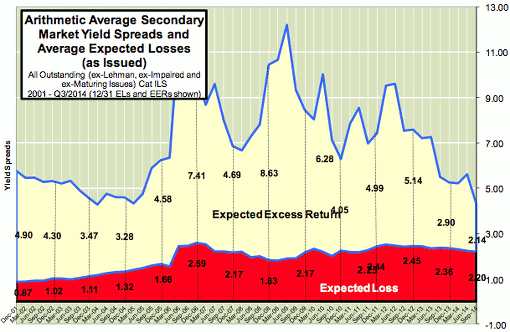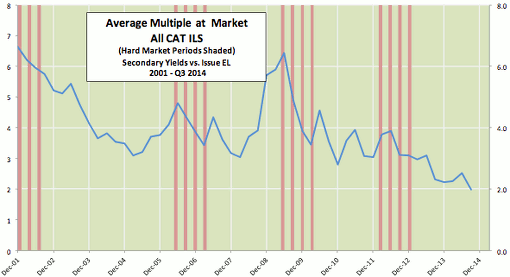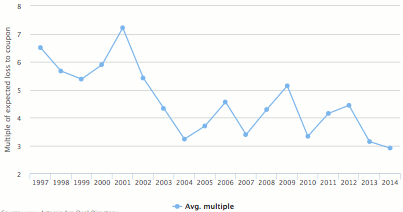The expected excess return, or the return available between average expected losses and the average yield spread, of outstanding catastrophe bonds has shrunk to its lowest level since ILS consultancy Lane Financial LLC began tracking the number.
As yields of catastrophe bond issues have declined over the last couple of years the excess return, between yield and expected loss, has more than halved in just two years. The average expected loss of the outstanding cat bond market has also been on a steady decline since early 2012, but yields have come down much more rapidly as catastrophe reinsurance and ILS rates have softened.
According to data from Lane Financial’s latest ILS market report, the average excess return of the outstanding catastrophe bond market at the end of 2012, based on arithmetic average secondary market yield spreads and average expected losses as issued, was 5.14% above an average expected loss of 2.45%.
At the end of September 2014 that had shrunk to an average excess return of just 2.14%, above an average expected loss of 2.2%. That significant decline, perhaps best viewed in the graphic below, is one of the best demonstrations of the lowering of prices of catastrophe bonds and also reinsurance as an asset class.

The average excess return of catastrophe bonds in steady decline - Source: Lane Financial
Artemis has its own version of this chart, showing the average coupon and the average expected loss at issuance (below), of all catastrophe bonds and ILS deals included in our Deal Directory each year. You can see the same trend, of a squeezing of the excess return between expected loss and coupon.
Our chart shows that the average expected loss of 2014 issuance so far is just 1.51% and the average coupon on those cat bond and ILS transactions issued this year is just 4.39%. Which implies an average excess return on 2014 vintage catastrophe bonds and ILS of just 2.88%, which is a little higher than Lane Financial’s number (but note our data includes cat bond lites and some private deals).
Lane Financial also measure the average multiple at market, defined as the secondary yield versus the expected loss at issue. Based on its latest chart (see below) the average multiple at market has also reached an all time low at just 2X expected losses.

Average catastrophe bond multiple at market - Source: Lane Financial
Again, we have a version of this chart which displays the average multiple of all catastrophe bonds and ILS included in our Deal Directory each year. Again, this is more simplistic as based on the issuance coupon level, but provides a good indication of investor risk appetite and what level of risk is being transferred in the market for what return each year. Our chart, which you can see below, shows 2014 vintage cat bond and ILS average multiples at 2.91X expected loss.
The excess return available and the multiple of cat bond and ILS transactions issued are useful indicators of pricing and investor appetite for assuming risk. The steady decline in expected excess return demonstrates the reduction in pricing and also ILS investors enhanced understanding of their cost-of-capital.
Of course, one thing that is missing from these charts is uncertainty. When new catastrophe bonds are issued, the expected loss is set by the third-party modelling firm working on the cat bond transaction issuance. Often the competing risk modelling firms will provide their view of the risk of the cat bond to their clients and the difference in metrics such as expected loss can be stark.
So, depending on whose view of the risk you trust most, the expected loss could be very different resulting in a greater, or even smaller, excess return. Insurance-linked securities (ILS) investors, as they become increasingly sophisticated, will also apply their own view of the risk which again could impact the excess return they feel a transaction offers.
The numbers here also do not really account for any unmodelled risk in catastrophe bonds issued in recent years, which are unknown factors in terms of their contribution to expected loss to a degree. So, depending on your view of risk, which risk models you prefer, how you weight unmodelled exposure contribution, you might narrow the expected excess return further or perhaps even widen it.
Check out our series of charts on the outstanding catastrophe bond market here. Two of particular relevance to this article are the Average coupon and expected loss by year and the Average multiple (expected loss to coupon) by year.
Also read our other article on the recent Lane Financial LLC report: ILS rates ‘plunge to new lows’, soft market prevails: Lane Financial.
 View all of our Artemis Live video interviews and subscribe to our podcast.
View all of our Artemis Live video interviews and subscribe to our podcast.
All of our Artemis Live insurance-linked securities (ILS), catastrophe bonds and reinsurance video content and video interviews can be accessed online.
Our Artemis Live podcast can be subscribed to using the typical podcast services providers, including Apple, Google, Spotify and more.

































